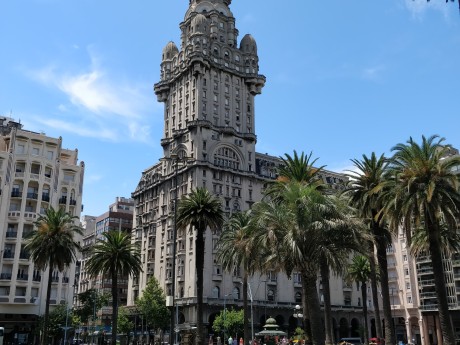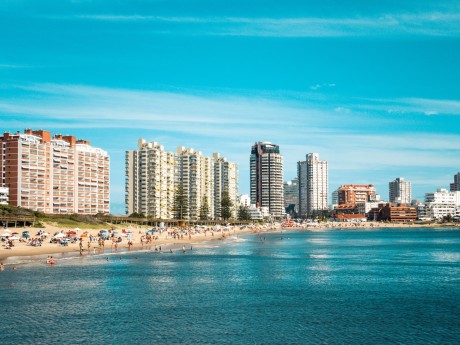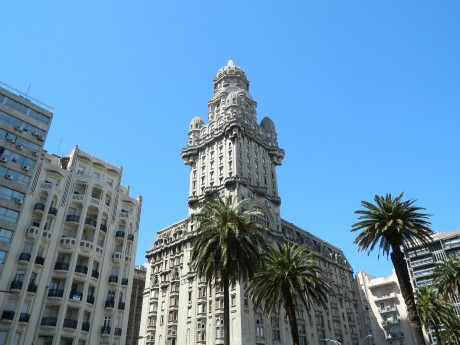Uruguay: Montevideo & Punta del Este
Enjoy Uruguay's rich culture and natural beauty, from the vibrant urban life of Montevideo to the glitz and glamour of Punta del Este's stunning beaches. In Montevideo, the country's capital and largest city, stroll along La Rambla, a picturesque promenade that stretches along the coastline. Explore Ciudad Vieja, the historic old town, and discover colonial architecture, art galleries, and charming cafes. Visit landmarks like the Salvo Palace and the Metropolitan Cathedral.
Read more
Enjoy Uruguay's rich culture and natural beauty, from the vibrant urban life of Montevideo to the glitz and glamour of Punta del Este's stunning beaches. In Montevideo, the country's capital and largest city, stroll along La Rambla, a picturesque promenade that stretches along the coastline. Explore Ciudad Vieja, the historic old town, and discover colonial architecture, art galleries, and charming cafes. Visit landmarks like the Salvo Palace and the Metropolitan Cathedral. Explore the vibrant Mercado de la Abundancia and the bustling Mercado de la Agricultura. Travel east to Punta del Este, a glamorous coastal resort town known for its beautiful beaches and upscale atmosphere. Soak up the sun on Playa Brava and Playa Mansa, and stroll along the Punta del Este harbor to admire luxury yachts and the iconic sculpture "La Mano." Indulge in world-class cuisine at Punta del Este's upscale restaurants. Visit Casapueblo, the unique "living sculpture" created by Uruguayan artist Carlos Páez Vilaró. Waterviews strives to offer accommodation options within walking distance of water and/or in an area of touristic interest. Our prices include taxes (but excludes local tourist taxes). Customize your trip to your personal preferences with optional activities (hit the “Add Activities’’) or change hotels, etc. Contact us for customization at no extra cost at: Service@waterviewstravel.com
Destinations
- Montevideo
- Punta del Este
Itinerary
Montevideo

Uruguay’s capital, Montevideo, is a vibrant and cosmopolitan city that offers an array of cultural and historical attractions. Offering a more low-key atmosphere than nearby Buenos Aires, the city has something for everyone, with plenty of museums, theatres and galleries as well as picturesque architecture, excellent cuisine and lively nightlife. Montevideo's friendly locals, compact size and relaxed atmosphere will make you forget that you are in a capital city, and the nearby beaches only add to its appeal.
Read more
Uruguay’s capital, Montevideo, is a vibrant and cosmopolitan city that offers an array of cultural and historical attractions. Offering a more low-key atmosphere than nearby Buenos Aires, the city has something for everyone, with plenty of museums, theatres and galleries as well as picturesque architecture, excellent cuisine and lively nightlife. Montevideo's friendly locals, compact size and relaxed atmosphere will make you forget that you are in a capital city, and the nearby beaches only add to its appeal.
Additional Information
History
There are several theories about the origins of the city's name. The "monte" part is generally considered to be the hill where the Cerro fort is now. According to one theory the hill was named "Monte-VI-D-E-O(este)", which translates to Mountain six (VI in Roman numerals) From East to West. Another popular theory is that a member of Ferdinand Magellan's world circumnavigation would have shouted "Monte vide eu!", which translates to "I see a mountain!" when seeing the hill - however the circumnavigation happened two centuries before the foundation of the city so it might well have been another mountain he saw.
Construction of the Cerro fort, at the time called Montevieu fort, was started by the Portuguese in 1723. The following year the Spanish started building the city of Montevideo on the opposite side of the bay where Ciudad Vieja is now, and occupied and colonized the rest of the region. During its almost 300 years of existence, Montevideo has been part of the Spanish and Portuguese empires, occupied by the British for a few months in 1807 and afterwards a part of Brazil and today's Argentina before finally becoming the capital of the newly-founded Republic of Uruguay in 1828.
The unrest of the mid-19th century, including an eight-year siege, was followed by a time of prosperity, and the region was a popular destination for European immigrants. The pompous villas and parks that can be seen for example in the Prado district date from this period. In the 1950s, an economic collapse led to the emergence of a left-wing guerrilla movement, followed by a military dictatorship lasting until 1985, when democracy was restored. Today, Uruguay is run by the democratic socialist party of the former guerrillas, and it is one of the safest Latin American countries with the GDP per capita being among the highest.
Climate
Since Montevideo is south of the Equator, it is summer there when it's winter in the Northern Hemisphere and vice versa. Montevideo is in the subtropics; in the summer months, temperatures above +30°C are common. The winter can be deceptively chilly: temperatures rarely go below freezing, but the wind and humidity combine to make it feel colder than what the thermometer says. There are no particular "rainy" and "dry" seasons: the amount of rain stays roughly the same throughout the year.
After it rains, loose sidewalk tiles can hide puddles of water. Watch your step to avoid getting splashed.
Orientation
Central areas
The city of Montevideo extends from the extreme southeast of Rio de la Plata along a circular gulf that offers a natural harbor.
The most interesting area for visitors is the old town (Ciudad Vieja) and Centro. The city's major sights, monuments and museums but also accommodation, theater and shops can be found there. The old town stretches along a small peninsula that abuts Montevideo Bay and the Centro immediately to the east.
Avenida 18 de Julio starts at Plaza Independencia, dominated by Palacio Salvo, an Art Deco highrise of 102m that is considered the symbol of Montevideo. Another point of interest in the old town is Plaza Constitución, colloquially named Plaza Matriz. Another sight is the former city hall palace (El Cabildo).
Towards the north of the old town one can find architecture reminiscent of Buenos Aires, and in the south it is delimited by the seaside promenade La Rambla that continues all the way to Parque Rodó. This is a popular area for outdoor activities like fishing, strolling or biking. Barrio La Aguada is an extension of the Centro towards north whose major point of interest is the parliament, built in neoclassical style. Barrio Tres Cruces is an important traffic center in the other end of Avenida 18 de Julio. The intercity and international bus station is there, together with a big shopping mall.
Eastern and Southern Montevideo
The coast east of Parque Rodó is known for its beaches. Its principal artery is Avenida Italia, a lively road connecting the city to the airport. The Rambla runs along the coast. The most important districts in this part of the city are: Palermo - A district associated with candombe and the Afro-Uruguayan community. Punta Carretas – Upscale district includes golf greens and Hotel Sheraton and Punta Carretas Shopping, a major shopping mall that is built on the remains of a prison (they preserved the prison gate inside the mall). Pocitos - This barrio lies about 3 km south-east of the city center. The Pocitos beach runs east from Punta Trouville for about 1.5 km. Highrise apartments ring the beach along the Rambla, but going inland a few blocks brings you into an older neighborhood reminiscent of San Francisco's Marina district. Buceo - East along the Rambla, home to one of the city's many beaches and the World Trade Center with its adjacent shopping mall. Malvín - Yet another upscale barrio with a long beach. Carrasco - Very upscale district with a variety of architectural styles in the easternmost part of the city.
Northern and western Montevideo
The northern and western parts include a couple of sights. The few dangerous barrios of Montevideo are in the northwestern outskirts. Barrio Reus – A small neighbourhood with charming colorful houses. Peñarol - Not only the name of the world famous football team but also an old well preserved railway district among the oldest in South America. Cerro - Seedy neighborhood best known for its fort overlooking Montevideo from the western side of the bay.
© Sourced from Wikivoyage
Punta del Este

Situated on Uruguay’s Atlantic Coast, Punta del Este is one of the country’s most sophisticated seaside resorts. Renowned for its excellent beaches, yacht-lined harbour and glitzy nightlife scene, Punta del Este is a hotspot for Latin America’s rich and famous. There are plenty of attractions here, and visitors can relax on golden sands, marvel at the architecture of the Casapueblo, enjoy world-class cuisine or take a boat trip to nearby Isla de Lobos to admire its colony of sea lions.
Read more
Situated on Uruguay’s Atlantic Coast, Punta del Este is one of the country’s most sophisticated seaside resorts. Renowned for its excellent beaches, yacht-lined harbour and glitzy nightlife scene, Punta del Este is a hotspot for Latin America’s rich and famous. There are plenty of attractions here, and visitors can relax on golden sands, marvel at the architecture of the Casapueblo, enjoy world-class cuisine or take a boat trip to nearby Isla de Lobos to admire its colony of sea lions.
Additional Information
The unspoilt Uruguayan peninsula of Punta del Este is all heavenly beaches, exotic sophistication, beautiful people and an ardent night scene. Punta del Este is sometimes called the Monaco of South America. There are many travel sights, including the amazing restaurants. In the last year there has been the shoots of urbanization in the form of high rise building obscuring the sun, however. Tourist season varies wildly from totally deserted in the winter to very very crowded in the summer, unusual for a city this size.
© Sourced from Wikivoyage





